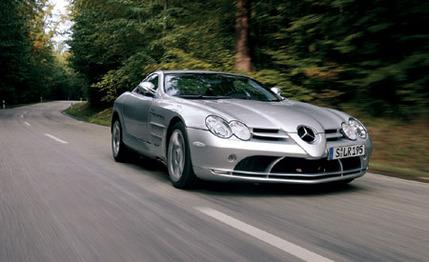
 Road Test
Road Test
As we floored the accelerator in the Mercedes-Benz SLR McLaren, there was a brief snap of wheelspin before the electronic stability control stepped in to balance the sudden tidal wave of torque against the grip of the car's 295/30ZR-19 rear Michelins. After that it was just a matter of listening to the deep staccato beat of the 5.4-liter supercharged V-8 hurtling the SLR down the relatively short runway at Malmsheim, near Stuttgart (where Mercedes organized this performance test for American magazines), and then tapping the shift button on the steering wheel each time the tach reached for its 7000-rpm redline.
Do that with any degree of proficiency, and you are rewarded with 0-to-60-mph sprints in just 3.6 seconds. The quarter-mile is dispatched in 11.6 seconds at 125 mph, and even that result might improve on a warmer surface. C/D's test session was the last of four and took place in the late afternoon, when October temperatures were on the decline.
Skilled testers can equal the launch performance of the SLR's stability-control system (ESP in Mercedes-speak) by switching to its second, less intrusive position and finessing the gas pedal for traction, but they can't beat it. In the normal ESP mode, you have very effective launch control, and since the SLR has 575 pound-feet of torque from 3250 rpm, that system is worth its weight in gold-plated connectors. It was also reassuring to know that the huge ceramic brake rotors and equally substantial calipers would quickly slough off speed at the end of each 130-mph run on the relatively short Malmsheim airstrip.
Dig into the loud pedal any time out on the road, and you'll be gob-smacked by the sheer ferocity of the AMG engine's response. It might involve a downshift to do it, but a big dig at the throttle produces the kind of thrust that had everyone in our group shaking their heads in awe. Just check out our 30-to-50 and 50-to-70 times, which at 1.7 and 2.4 seconds are the best pair of top-gear acceleration times we've ever recorded for a production car.
In any situation other than a dry day on a straight road, a deep prod at the throttle will likely be answered by the activities of both engine and electronic watchdogs. The engine wants to give its all while the electronic systems are trying to save your life. Even then, we had a couple of occasions in traffic when a stab at the pedal produced a brief twitch of the tail.
That explains why Mercedes will not allow the ESP to be switched off completely. In fact, while we were pondering this strategy during a break at the test session, someone asked why one even needs 617 horsepower in a streetgoing car. The answer came from another writer: "To reach 207 mph."
Exactly. If a company with a long motorsports history wants to flaunt its heritage in a car that evokes both the 300SLR of old and the Formula 1 McLaren of right now, it needs to breech the 200-mph mark in the same way Ferrari's Enzo does. To push a big car like the SLR through an increasingly resistant atmosphere to the 200-mph mark-particularly when it has a flat bottom, front and rear diffusers, and a tail spoiler designed to provide downforce at speed-you need big horsepower.
Mercedes performance partner AMG knows where to find it. AMG knows how to package it, too. Looking at a fully dressed AMG SLR engine, one can readily appreciate the unit's compact size. The 5.4-liter V-8 in the SLR wears single-overhead-cam three-valve heads that are remarkably compact. The twin-screw blower resides in the valley between the cylinder banks, where it takes up very little space. A dry-sump lubrication system allows the V-8 to be housed lower than with a conventional oil pan.